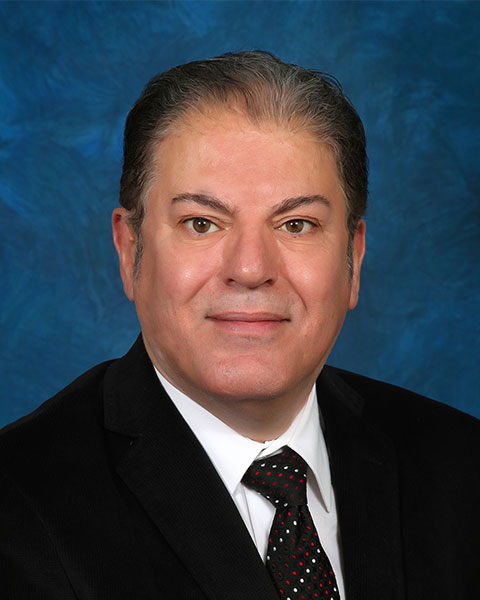PQA 02 - PQA 02 Physics Poster Q&A
2370 - Dose-Response Modeling of Dysphagia and Xerostomia for Previously Irradiated Head and Neck Cancer
Sunday, September 29, 2024
4:45 PM - 6:00 PM ET
Location: Hall C
Screen: 20

Moyed Miften, PhD, FASTRO
University of Colorado School of Medicine
Aurora, CO
Presenter(s)
M. Miften, Q. Diot, D. Dunkerley, A. Avant, L. McLean-Thomas, and R. M. Lanning; Department of Radiation Oncology, University of Colorado School of Medicine, Aurora, CO
Purpose/Objective(s): Re-irradiation (re-RT) of recurrent head and neck cancer (HNC) using modern RT techniques is a viable treatment strategy, however, normal tissue toxicity remains high. In this work, we quantify the risk of re-RT induced dysphagia and xerostomia in patients with loco-regionally recurrent HNC who received a second course of RT with curative intent. Materials/
Methods: Dose-volume data from 54 HNC patients that underwent a second course of treatment to a dose of 18-70 Gy [median, 32.5 Gy] in 3-35 fractions [median, 5] were retrospectively reviewed. Four patients were excluded due to laryngectomy and parotidectomy. Toxicity data per the CTCAE criteria were analyzed for 16 and 12 patients who experienced late grade = 2 dysphagia and xerostomia, including 5 and 2 patients with grade 3, respectively. Data were fitted independently to a Probit model using a maximum log-likelihood optimization. To account for the different fractionations, the mean dose was computed for EQD2. Dose-response using normal tissue complication probability (NTCP) models were then generated to predict risk of grade = 2 dysphagia as function of mean dose to the supraglottic larynx. To quantify the risk to salivary flow reserve, NTCPs were also generated to model the incidence of grade = 2 xerostomia as function of mean dose to contra-parotid gland and mean dose to contra-submandibular gland.
Results: The most common diagnosis was squamous cell carcinoma (80%) with 52% of patients receiving systemic therapy. Median follow up was approximately 3-6 months. Interval between the first and second of irradiations was 4-356 months [median, 22]. Modeling results show the risk of dysphagia with supraglottic larynx dose resulting in 50% complication probability (D50) was 13.9 Gy [68% CI 9.6-23 Gy] and normalized dose-response gradient (?50) was 1.32 [68% CI 1.00-2.43]. The D30 resulting in 30% complication probability was 4.2 Gy [68% CI 15-43%]. The risk of dysphagia with a dose to 5 cc of supraglottic larynx (D5cc) of 5.6 Gy was 30% [68% CI 16-45%] and increases to 50% [68% CI 30-81%] with a D5cc of 18.4 Gy. Model parameters that predict the risk of xerostomia were contra-parotid D50 of 9.2 Gy [68% CI 5-118 Gy] and ?50 of 1.31 [68% CI 0.97-1.92], and contra-submandibular gland D50 of 7.4 Gy [68% CI 5.1-9.9] and ?50 of 0.99 [68% CI 0.87-1.78]. The D30 for contra-parotid and contra-submandibular were 2.9 Gy [68% CI 25-42%] and 3.6 Gy [68% CI 21-37%], respectively.
Conclusion: Risk of late dysphagia and xerostomia toxicities following re-RT for recurrent, previously irradiated HNC is less than 30% with supraglottic larynx, contra parotid, and contra -submandibular mean doses of 4.2, 2.9, and 3.6 Gy respectively. Dose data of laryngeal, parotid, and submandibular structures should be carefully assessed prior to re-RT. Our results may be incorporated as dose-volume constraints in future re-RT clinical trials.
Purpose/Objective(s): Re-irradiation (re-RT) of recurrent head and neck cancer (HNC) using modern RT techniques is a viable treatment strategy, however, normal tissue toxicity remains high. In this work, we quantify the risk of re-RT induced dysphagia and xerostomia in patients with loco-regionally recurrent HNC who received a second course of RT with curative intent. Materials/
Methods: Dose-volume data from 54 HNC patients that underwent a second course of treatment to a dose of 18-70 Gy [median, 32.5 Gy] in 3-35 fractions [median, 5] were retrospectively reviewed. Four patients were excluded due to laryngectomy and parotidectomy. Toxicity data per the CTCAE criteria were analyzed for 16 and 12 patients who experienced late grade = 2 dysphagia and xerostomia, including 5 and 2 patients with grade 3, respectively. Data were fitted independently to a Probit model using a maximum log-likelihood optimization. To account for the different fractionations, the mean dose was computed for EQD2. Dose-response using normal tissue complication probability (NTCP) models were then generated to predict risk of grade = 2 dysphagia as function of mean dose to the supraglottic larynx. To quantify the risk to salivary flow reserve, NTCPs were also generated to model the incidence of grade = 2 xerostomia as function of mean dose to contra-parotid gland and mean dose to contra-submandibular gland.
Results: The most common diagnosis was squamous cell carcinoma (80%) with 52% of patients receiving systemic therapy. Median follow up was approximately 3-6 months. Interval between the first and second of irradiations was 4-356 months [median, 22]. Modeling results show the risk of dysphagia with supraglottic larynx dose resulting in 50% complication probability (D50) was 13.9 Gy [68% CI 9.6-23 Gy] and normalized dose-response gradient (?50) was 1.32 [68% CI 1.00-2.43]. The D30 resulting in 30% complication probability was 4.2 Gy [68% CI 15-43%]. The risk of dysphagia with a dose to 5 cc of supraglottic larynx (D5cc) of 5.6 Gy was 30% [68% CI 16-45%] and increases to 50% [68% CI 30-81%] with a D5cc of 18.4 Gy. Model parameters that predict the risk of xerostomia were contra-parotid D50 of 9.2 Gy [68% CI 5-118 Gy] and ?50 of 1.31 [68% CI 0.97-1.92], and contra-submandibular gland D50 of 7.4 Gy [68% CI 5.1-9.9] and ?50 of 0.99 [68% CI 0.87-1.78]. The D30 for contra-parotid and contra-submandibular were 2.9 Gy [68% CI 25-42%] and 3.6 Gy [68% CI 21-37%], respectively.
Conclusion: Risk of late dysphagia and xerostomia toxicities following re-RT for recurrent, previously irradiated HNC is less than 30% with supraglottic larynx, contra parotid, and contra -submandibular mean doses of 4.2, 2.9, and 3.6 Gy respectively. Dose data of laryngeal, parotid, and submandibular structures should be carefully assessed prior to re-RT. Our results may be incorporated as dose-volume constraints in future re-RT clinical trials.
